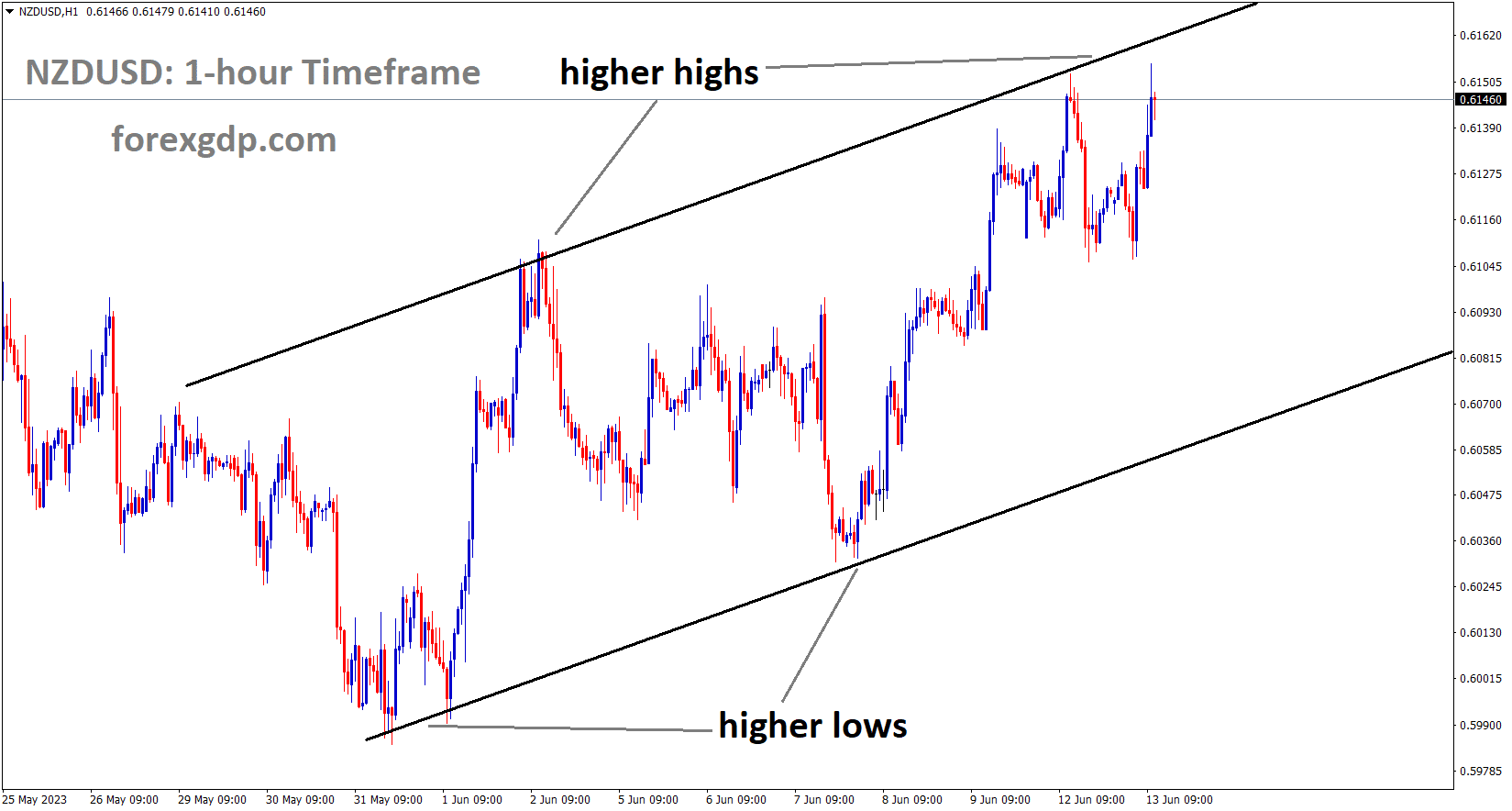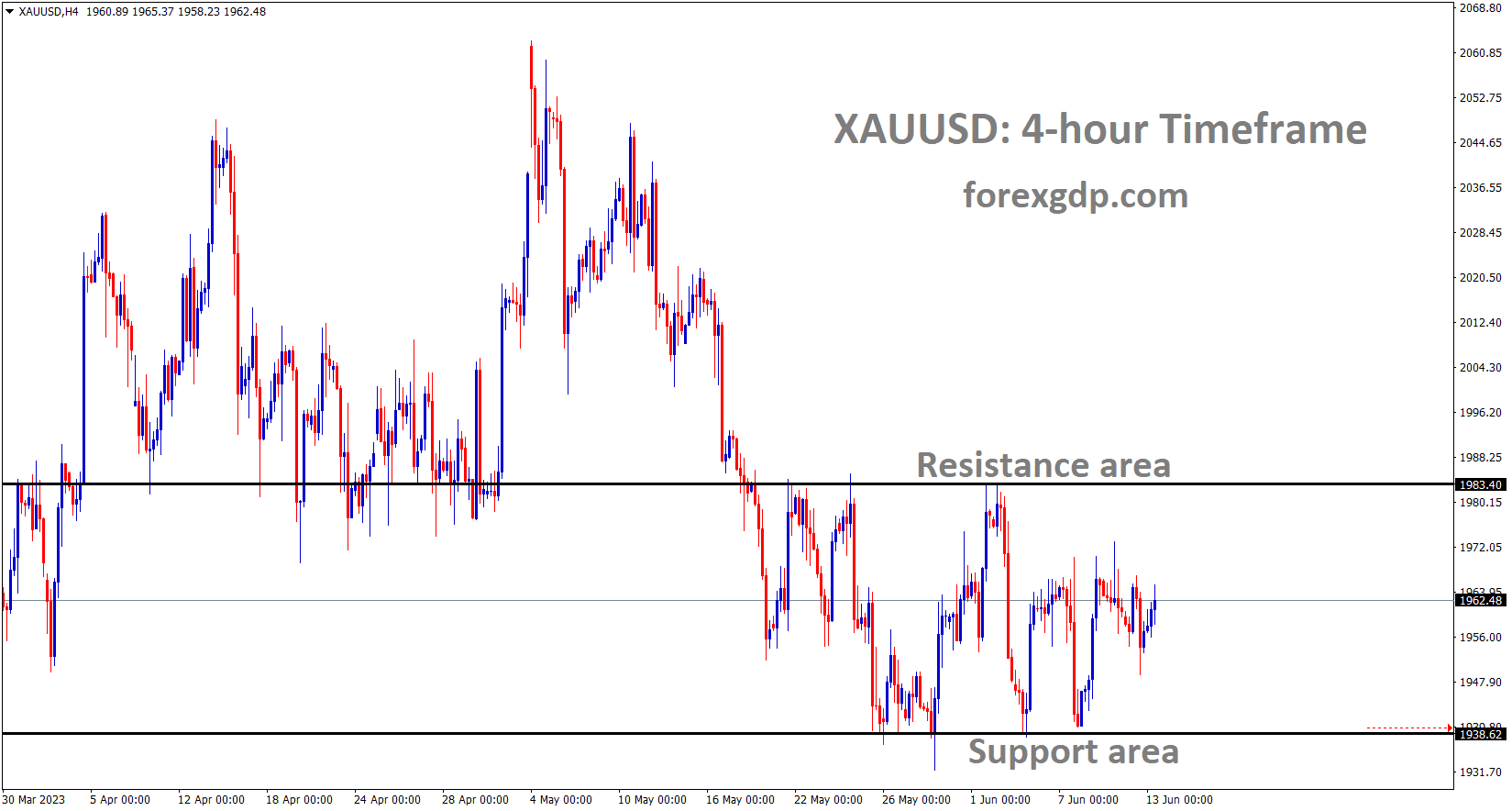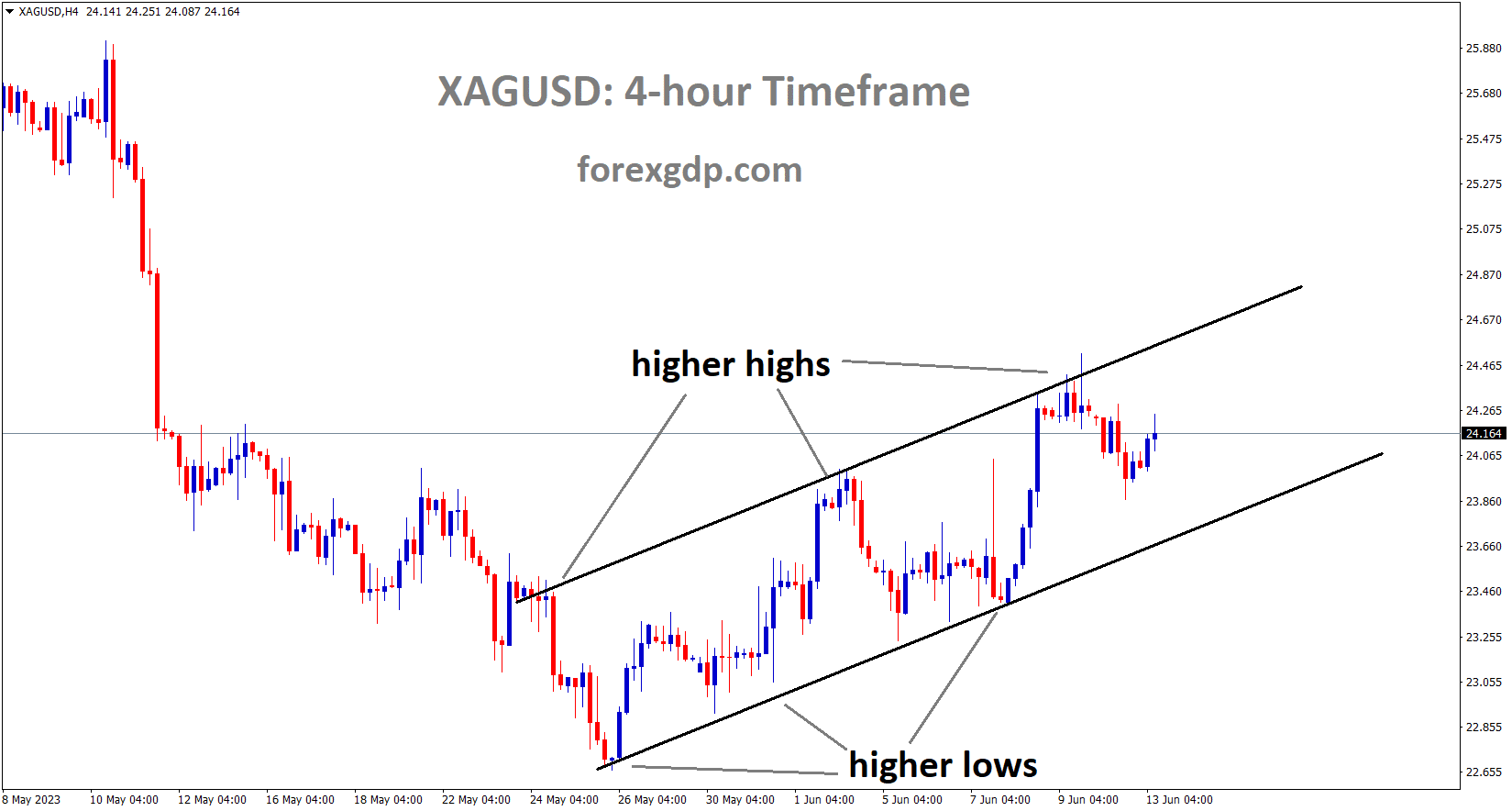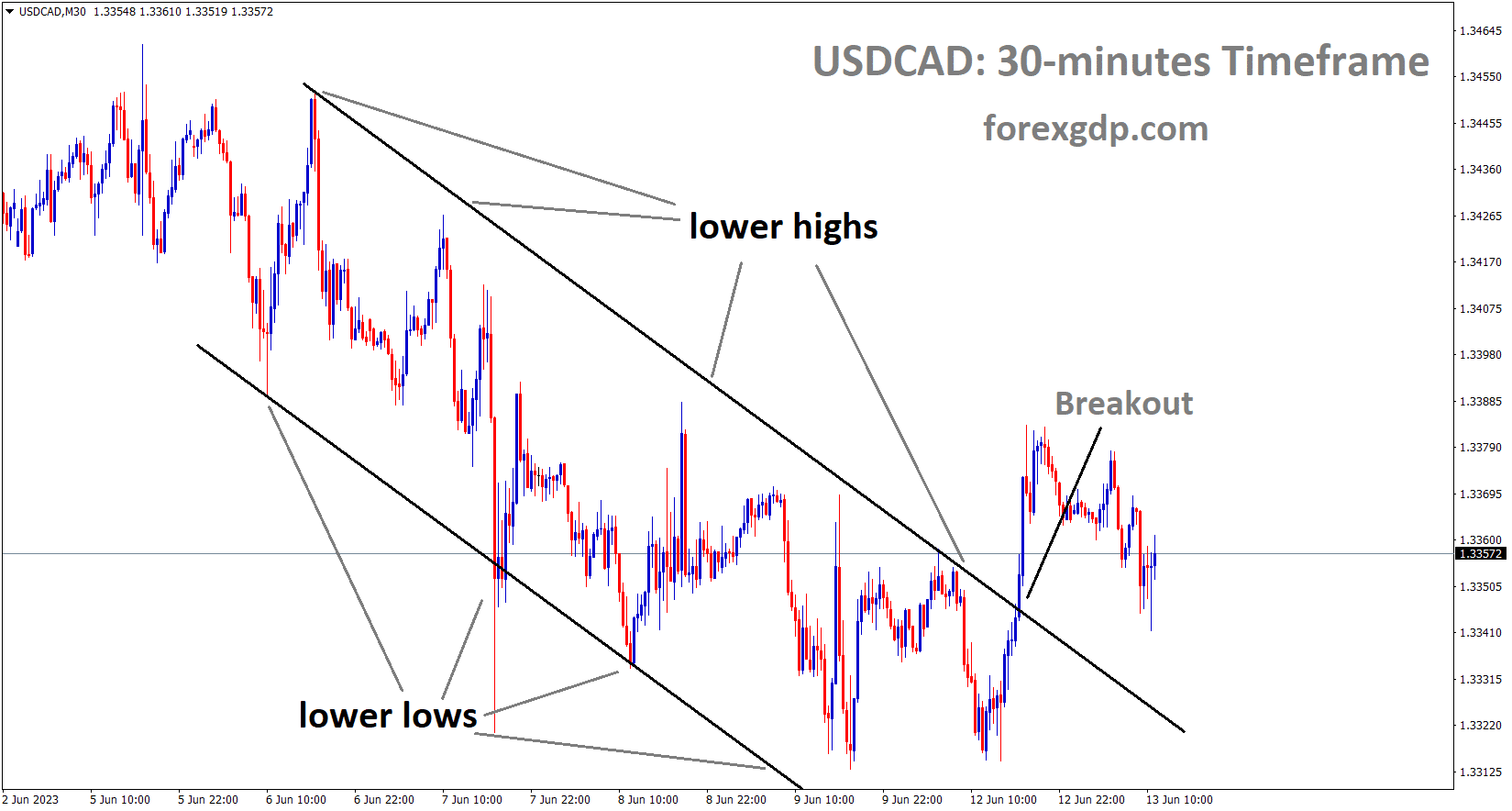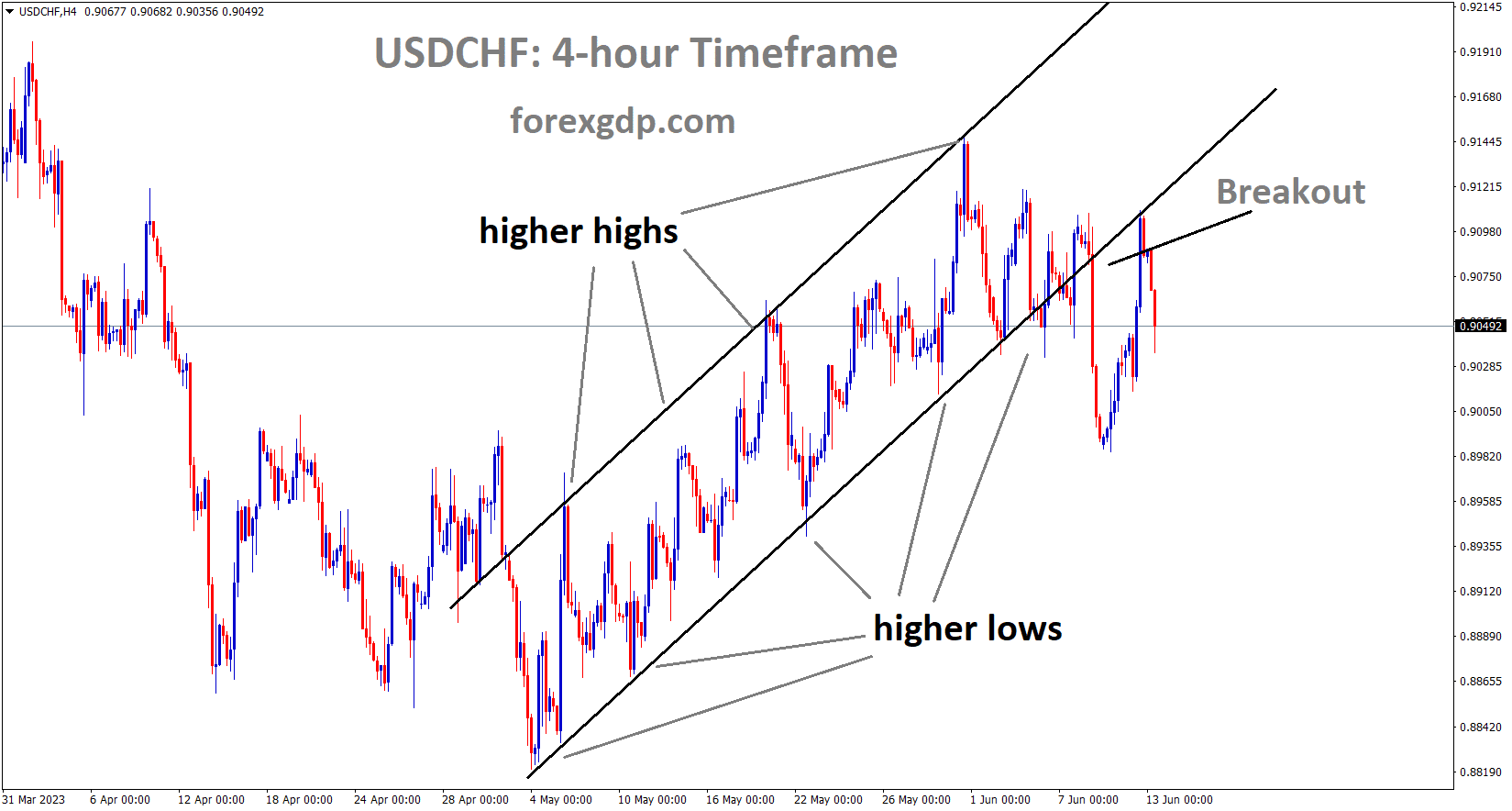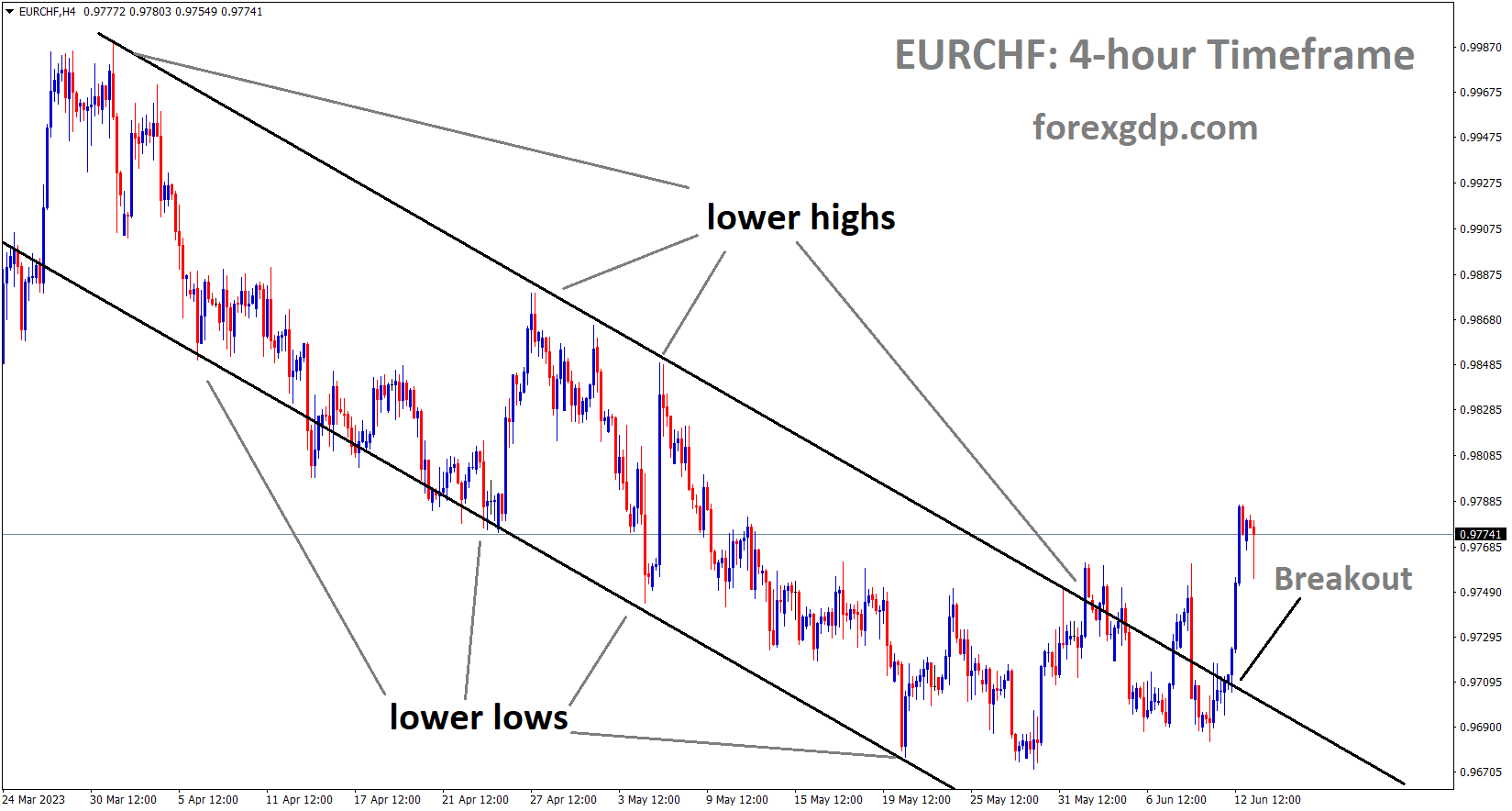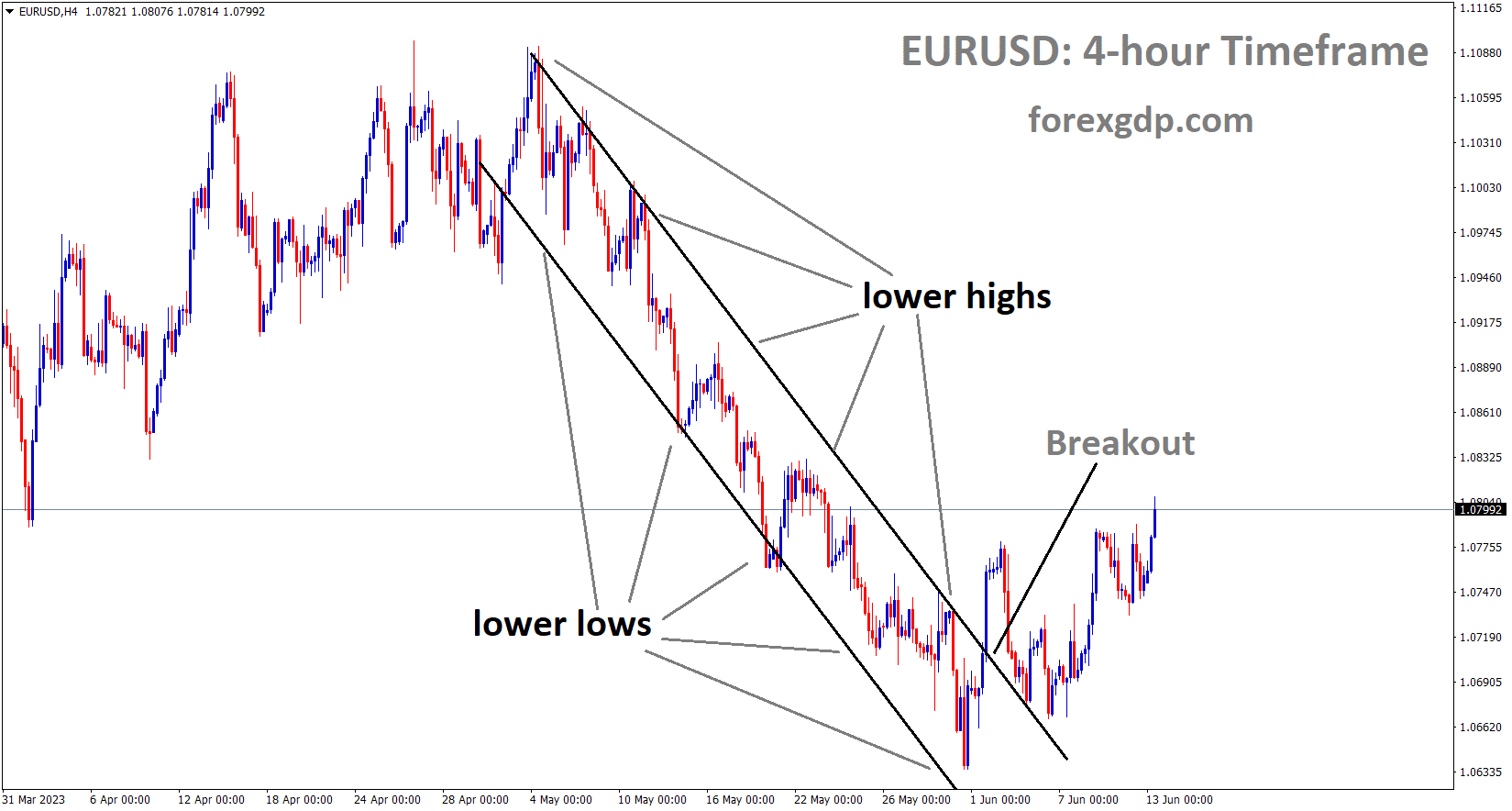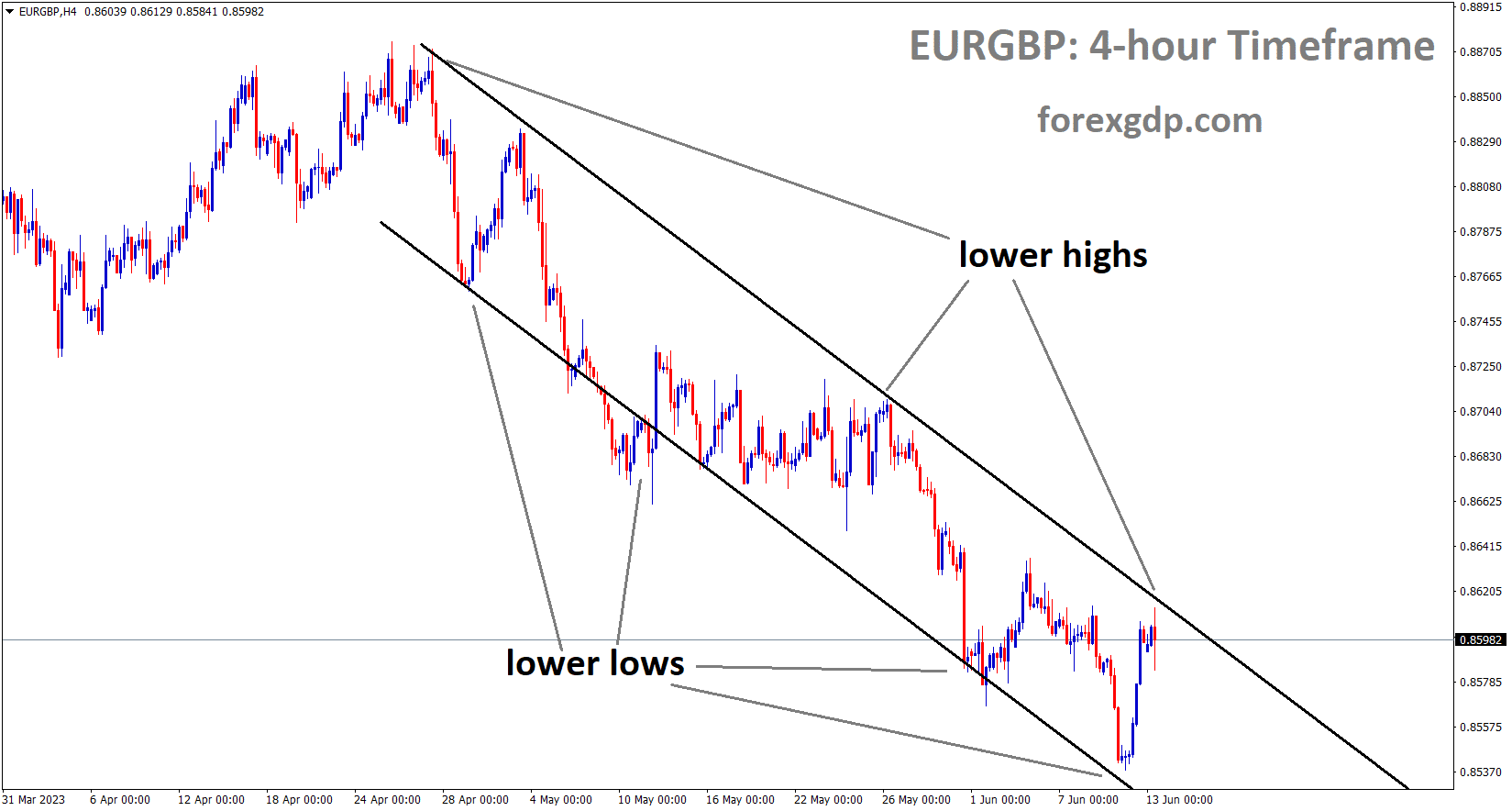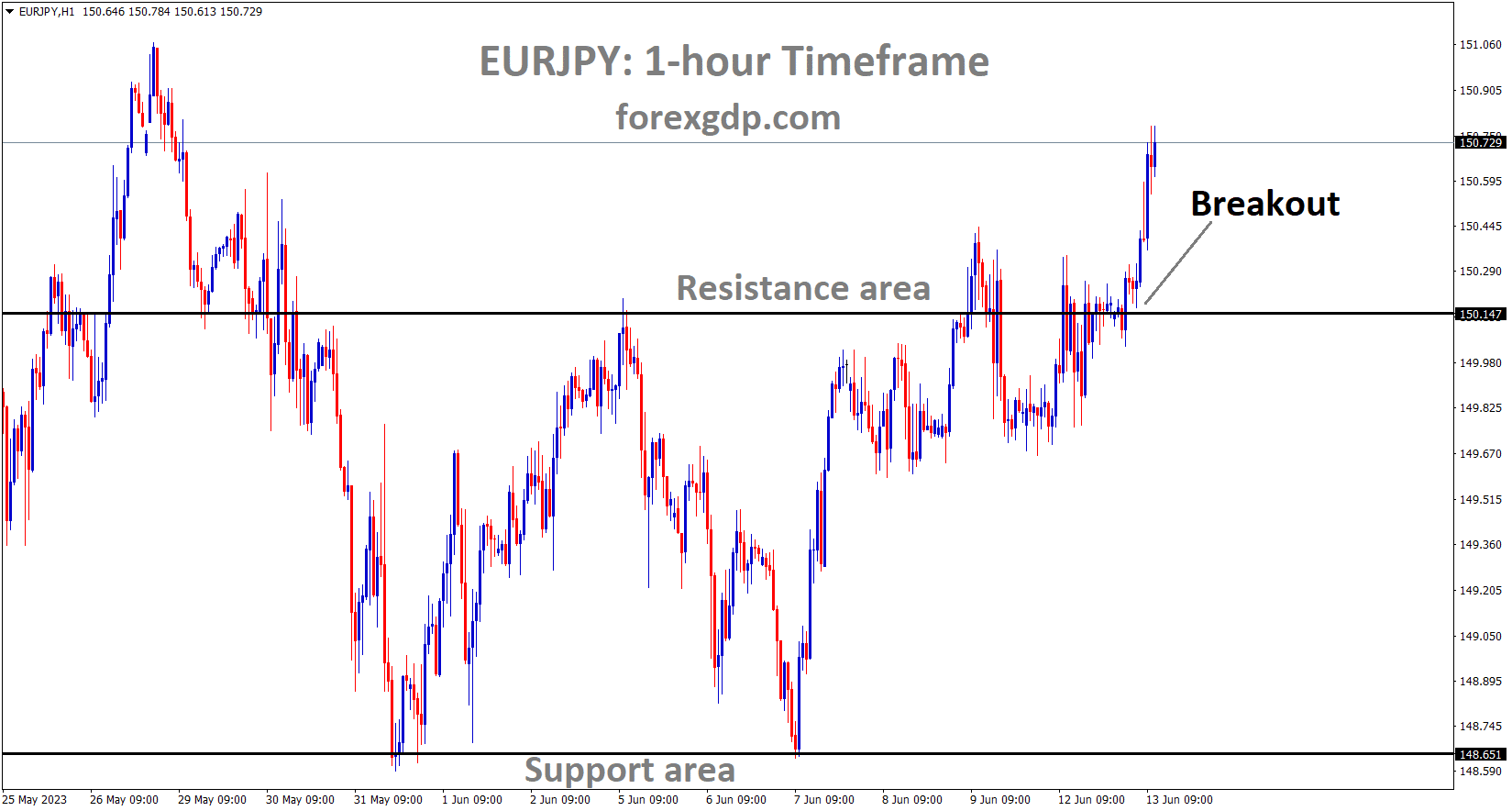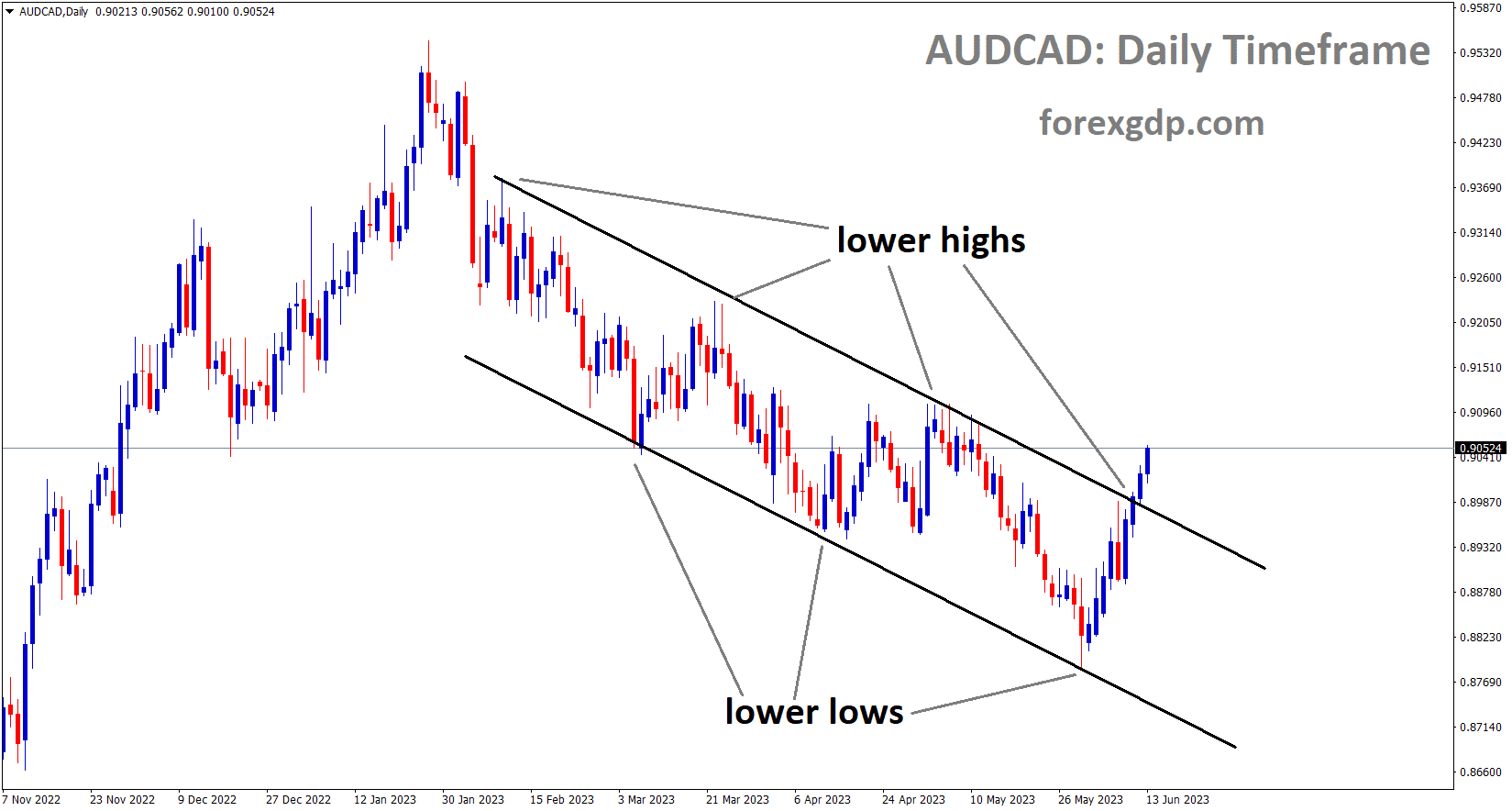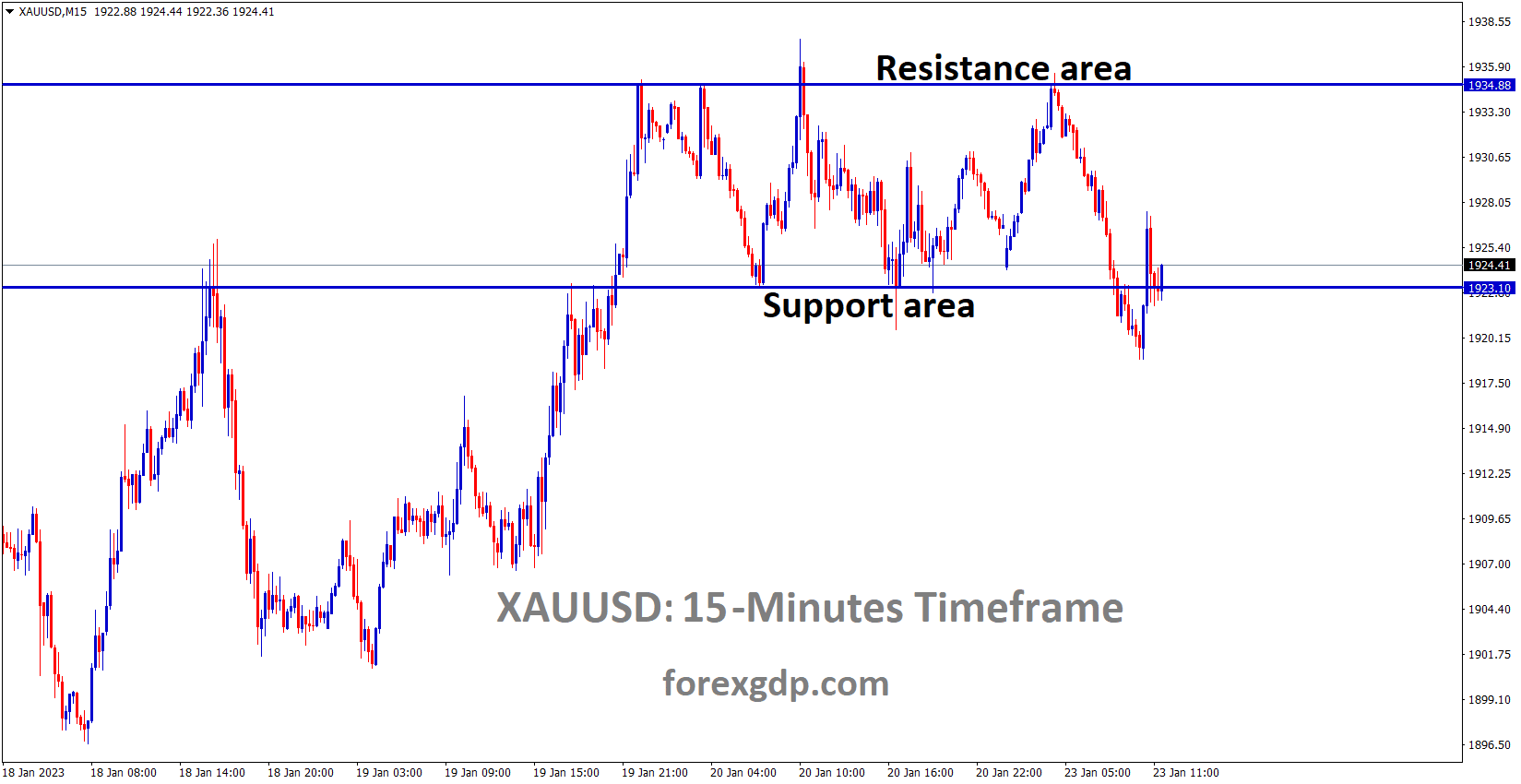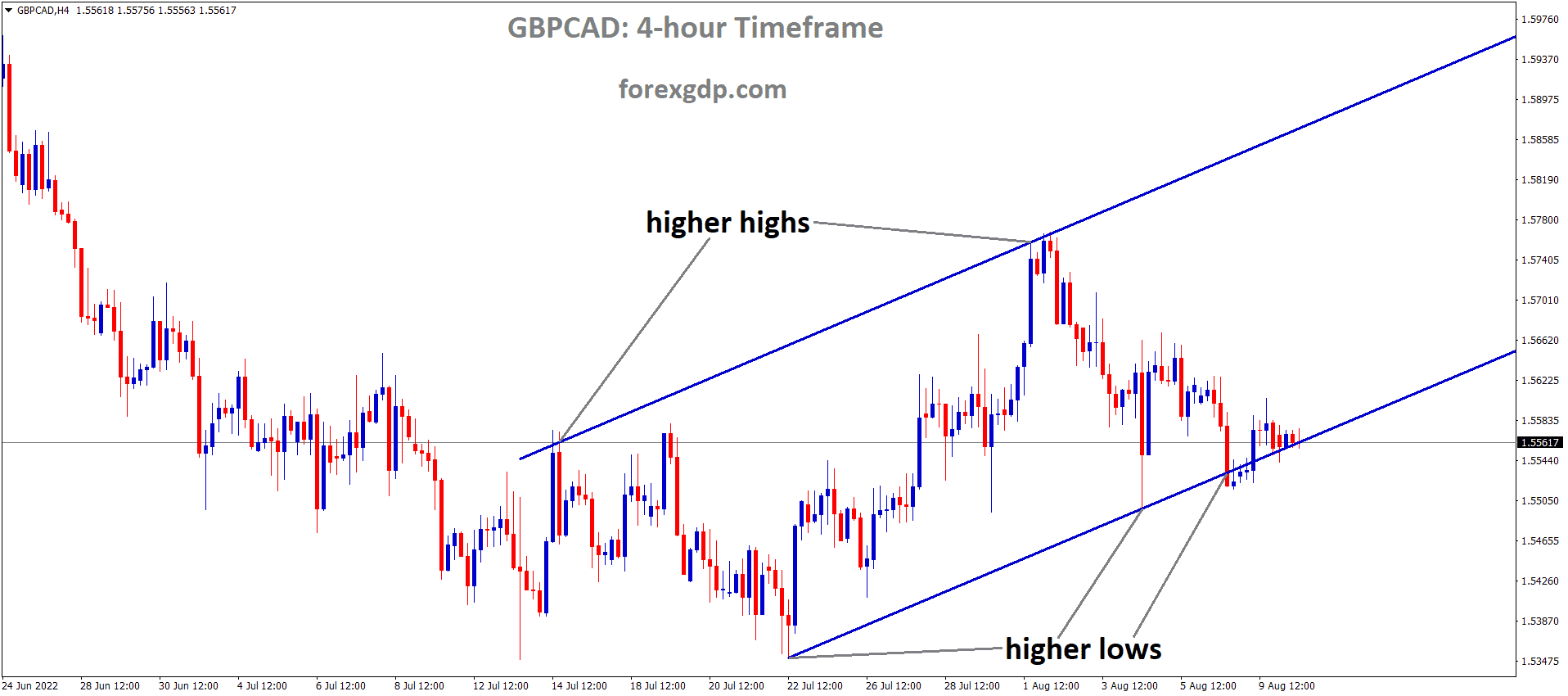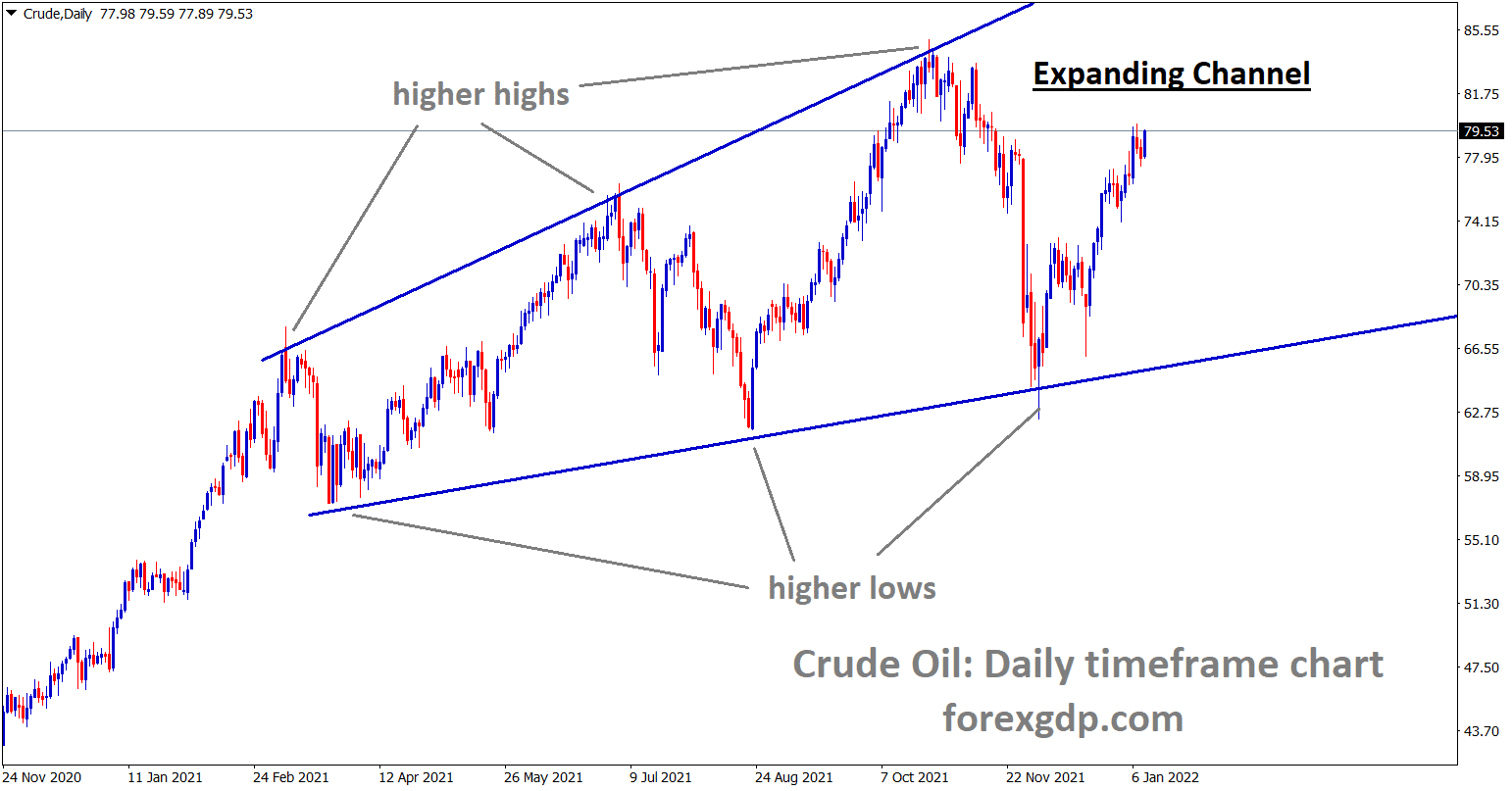NZDUSD Analysis
NZDUSD is moving in an Ascending channel and the market has reached the higher high area of the channel.
NZD GDP Data is predicted to contract by 0.10 percent in the first quarter of 2023, which will push New Zealand into a technical recession after the previous quarter shrank by 0.6 percent in 2022. The Central Bank will increase interest rates more in the coming months as a result of the New Zealand economy’s high migration and tourism visits.
According to a Reuters poll, the aggressive cash rate hike by the New Zealand central bank put the country in a technical recession in the first quarter, supporting the theory that the cash rate may have peaked. A Reuters poll of 13 economists predicts that the gross domestic product will contract 0.1% in the March quarter, falling short of the Reserve Bank of New Zealand’s prediction of 0.3% growth.
GOLD Analysis
XAUUSD Gold Price is moving in the Box Pattern and the market has rebounded from the horizontal support area of the pattern.
Prior to today’s US CPI and tomorrow’s FED interest rate decision, gold prices are consolidating. The market’s falling Treasury Yields will benefit yellow metal as a result of a slower CPI and a pause in rate hikes. Bloomberg Survey predicts that US CPI MoM will reach 0.10% as opposed to the previous 0.40%.
As the market considers potential US CPI and PPI results ahead of the Fed’s Federal Open Market Committee (FOMC) meeting late Wednesday, the price of gold edged up to start Tuesday’s session. In the early going of this week, Treasury yields have been remarkably stable before the crucial inflation data and monetary policy meeting. The 2s 10s curve inversion continues to be very negative below -0.80%, but the bond market’s commentary does not seem to have much of an impact on the equity markets. The US 10-year real yield is currently trading above 1.5% at the same time that nominal yields have reached a plateau. The market-priced inflation rate derived from Treasury inflation-protected securities for the same tenor less the nominal yield results in the real yield. If the CPI data released later today significantly deviates from forecasts, the real yield may experience volatility, which could cause the gold price to respond accordingly. The yellow metal was below US$ 1,850 in February when the 10-year real yield was at these levels.
SILVER Analysis
XAGUSD Silver Price is moving in an Ascending channel and the market has fallen from the higher high area of the channel.
According to a Bloomberg survey of economists, the CPI will increase by 0.4% from the previous month to 0.1% in May. On the DailyFX calendar, additional information about the data is available. Tuesday’s US Dollar has been slightly weaker, which has allowed crude oil to recover from a 5-week low. While the Brent contract is just over US$ 72 bbl, the WTI futures contract is close to that price.
When the People’s Bank of China (PBOC) reduced the 7-day reverse repo rate from 2% to 1.9%, the markets received a small boost. After receiving a boost from the Wall Street close, APAC stocks are largely slightly up. Futures indicate that the cash session will begin steadily.
USDCAD Analysis
USDCAD has broken the Descending channel in upside.
Due to worries about a global demand slowdown, oil prices have fallen over the past two weeks. Due to concerns about slow economic growth, China reduces the repo rate from 2.0% to 1.9%. In contrast to Saudi Arabia’s oil cut, the US-Iran oil deal will increase the supply of oil. Only the rate increase by the Bank of Canada last week helped the Canadian Dollar.
As it rises off the daily low to 1.3365 heading into Tuesday’s European session, USDCAD attracts bids to reduce intraday loss. In doing so, the Loonie pair struggles to explain the most recent US Dollar weakness in light of the weak price of WTI crude oil, Canada’s main export good. However, the market’s cautious attitude in advance of important data/events, such as the US inflation and Federal Reserve (Fed) monetary policy meeting, could also be a factor in the quote’s most recent inaction. US Dollar Index records its first daily decline in three days, falling 0.20% intraday to close to 103.43 at press time. It is important to note that the negative expectations for Wednesday’s Federal Open Market Committee monetary policy meeting are reflected in the greenback’s index against six major currencies. Insufficient Fed talks combined with previously dovish US activity and job clues allowed traders to maintain their favourable views of the US central bank. While portraying the same, the CME’s FedWatch Tool suggests that there is a greater than 70% chance that the Fed will remain silent on Wednesday while there are almost 80% odds in favour of an increase in interest rates of 0.25% in July.
While consolidating its biggest daily decline in two weeks during sluggish markets, WTI crude oil, on the other hand, picks up bids to print modest gains around $67.70. Given that Beijing is one of the biggest energy consumers in the world, worries that China’s economy is losing momentum also affect the price of WTI. The People’s Bank of China reduces the repo rate from 2.0% to 1.9% and confirms earlier concerns about slower economic growth in the largest industrial player in the world. Bloomberg reported that, in light of this, “China’s central bank cut a short-term policy interest rate, easing its monetary stance to help aid the economy’s recovery.” Additionally, the hawkish stance of Saudi Arabia and the OPEC+ to pressure the Oil traders contrasts with hopes that the US-Iran deal will reveal increased energy output at a time of slower economic recovery. In the midst of these manoeuvres, the S&P500 Futures record slight gains at their highest level since April 2022, while the US 10-year and two-year Treasury bond yields decline for the second straight day to roughly 3.72% and 4.56%, respectively. Future USDCAD pair trading should focus on the US Consumer Price Index numbers for May as the Fed decision on Wednesday is expected to result in no change to interest rates. It is important to note that the market anticipates that the 0.4% Core CPI MoM figure will remain unchanged, as softer numbers could delay concerns about a rate hike in July and prevent the Fed from sounding hawkish.
USDCHF Analysis
USDCHF has broken the Ascending channel in downside.
After the massive merger with Credit Suisse, Sergio Ermotti was appointed as UBS’s CEO. Colm Kelleher, the chairman of UBS, congratulated Ermotti for performing better as a pilot than previous CEOs.
After the takeover was completed, Sergio Ermotti was reinstated as chief executive of UBS and given the difficult task of orchestrating the merger with Credit Suisse. Today we welcome our new colleagues from Credit Suisse to UBS,” he said, promising that together they would build a bank that would make Switzerland, its citizens, and its investors proud. Ermotti must resolve the contentious shotgun union of two of the biggest banks in the world. The silver-haired 63-year-old is referred to as the George Clooney of Paradeplatz after the Hollywood actor and the Zurich square at the centre of Switzerland’s banking industry. He is renowned for always being perfectly dressed. The Swiss banker, who oversaw Switzerland’s largest bank from 2011 to 2020, has a reputation befitting of such star billing after turning around UBS’s fortunes following the 2008 global financial crisis.
His rise from a local apprentice to the twice-elected boss of a major international bank has also been like something out of a Hollywood film. The new megabank’s sheer size has sparked concern in Switzerland in the event that it encounters trouble at some point in the future, as Ermotti has warned that the upcoming months will be “bumpy” for it. He was asked if he saw himself as a sort of Superman figure, a clean-up man in charge of reestablishing order, or the new coach of a football team at the Swiss Economic Forum conference on Friday in Interlaken. He opted for the latter, explaining that the challenge was to create something positive out of an unfavourable circumstance. Ermotti will have to combine two organisations that were both listed among the 30 banks around the world that the banking system considered to be of global significance, or simply too big to fail. As investor confidence waned in the wake of the failure of three American banks, Credit Suisse’s share price fell on March 15.
EURCHF Analysis
EURCHF has broken the Descending channel in upside.
To keep Credit Suisse from collapsing and potentially sparking a global banking meltdown, the Swiss government, central bank, and financial regulators coerced UBS into purchasing it for $3.25 billion on March 19. Colm Kelleher, the chairman of UBS, again turned to Ermotti, believing that he was the “better pilot” to guide the bank through its drastically altered course than its Dutch CEO Ralph Hamers. On April 5, Ermotti took over again after Hamers swiftly left the position.Ermotti once envisioned a career in football, but he distinguished himself as one of the best bankers of his generation instead. In his hometown of Lugano, in the Italian-speaking south of Switzerland, he dropped out of school at the age of 15 to work as an apprentice at the Corner private bank. He then set off on a brilliant journey that is viewed as a shining example of the Swiss apprenticeship system. After working for Citigroup briefly, he progressed through Merrill Lynch’s ranks between 1987 and 2004, completing his training at Oxford University’s prestigious advanced management programme along the way.
He spent five years working for the Italian bank UniCredit, where he was most notable for leading the division of markets and investment banking. The CEO position at UBS was then given to him, and from 2011 to 2020, he oversaw Switzerland’s largest bank. After being bailed out by the government during the 2008 financial crisis, UBS faced harsh criticism. The straw that broke the camel’s back, however, was a rogue trader’s losses of $2.3 billion in questionable transactions in 2011. Ermotti, who was little known in Switzerland and had spent the majority of his career in London, New York, and Milan, was the focus of UBS’s attention as heads rolled.
But after being passed over for the CEO position at UniCredit, he went back home. He made changes to the investment bank, shifted UBS’s emphasis to wealth management, and resolved the conflicts the bank had accumulated, such as the Libor and exchange rate manipulation scandals. He was appointed chairman of the massive Swiss Re reinsurance company in 2021. Ermotti claimed, however, that when Kelleher approached him about returning to UBS to integrate Credit Suisse, he felt compelled to do so.
EURUSD Analysis
EURUSD has broken the Descending channel in upside.
Due to consistently declining factory activity, Q1 GDP decreased by 1%. Germany’s recession started after two consecutive quarters of negative GDP printing. The widely anticipated 25bps rate increase by the ECB this week will strengthen the euro against other currency pairs.
After a sharp recovery from 1.0743, the Euro has pushed the major currency pair closer to the round-level resistance of 1.0800. Investors’ focus has been on the EUR/USD pair due to a stronger risk appetite theme and expectations of a reduction in the policy divergence between the Federal Reserve (Fed) and European Central Bank (ECB). This week, the Euro is anticipated to take a volatile turn as ECB President Christine Lagarde announces the bank’s interest rate decision for June. The US dollar will experience greater volatility as the Federal Reserve announces its interest rate policy on Wednesday. Prior to that, however, there is expected to be a lot of activity on the major currency pair ahead of the release of the US consumer price index data, which will take place on Tuesday at 12:30 GMT. The US inflation data is the only thing that the market participants are paying attention to because it will give important information about the Fed’s policy.
A 0.2% increase in monthly headline inflation is anticipated, which is less than the 0.4% increase seen in April. However, the core CPI’s monthly rate, which excludes the cost of food and oil, is expected to remain constant at 0.4%. While the energy component is expected to have a negative impact on headline inflation, core CPI is predicted to remain stable due to strong demand for durable goods and services.An underwhelming US CPI reading would strengthen the case for the Federal Reserve to announce a neutral interest rate policy, as other catalysts like employment and economic activity are supporting the case for an unchanged interest rate decision. The US unemployment rate has increased to 3.7%, and for the past three weeks, weekly initial claims have been rising steadily. The service sector in the US has hardly shown any expansion over the past seven months, and factory activities have been declining steadily during that time. Robert Kaplan, a former president of the Dallas Fed Bank, stated in an interview early on Tuesday that he would support a hawkish pause at the meeting this week. More interest rate increases are less likely, according to Fed Chair Jerome Powell, as tight lending standards by US commercial banks are stifling inflationary pressures. On June 21 before the Senate Banking Committee, US President Joe Biden will announce the Federal Reserve Vice Chair and fill the open Fed Board seat. Adriana Kugler, an economist, would fill a vacant Fed Board seat. The next vice chair is anticipated to be Fed Governor Philip Jefferson.
Despite growing concerns about a European recession, ECB President Christine Lagarde is anticipated to increase interest rates by 25 basis points (bps) to 4.25%. The final estimate of the first quarter’s gross domestic product for the Eurozone decreased by 0.1%, driven primarily by consistently declining factory output. After registering a contraction for two consecutive quarters, the German economy has already been classified as being in a recession. The ECB and Fed’s policy divergences would be reduced by an increase in interest rates by the ECB and no change in the Fed’s stance. In spite of the bullish market sentiment, the US Dollar Index is making an effort to hold onto its immediate support of 103.35.
EURGBP Analysis
EURGBP is moving in the Descending channel and the market has reached the lower high area of the channel.
The UK’s ILO unemployment rate for the three months of April looks good at 3.8% Versus the previous reading of 3.9%, and the change in claimant counts for the month of May decreased to -13.6K vs. -9.6K expected. Positive UK unemployment rate boosts GBP today against counter pairs.
Prior to Tuesday’s European session, the EURGBP reverses from its intraday high and reduces its daily gains to about 0.8590 with a sharp 20-pip decline. As a result, the cross-currency pair is negatively impacted by the UK jobs report and Germany’s unimpressive statistics. However, the UK claimant count change for May fell to -13.6K versus -9.6K anticipated and 46.7K prior, and the ILO unemployment rate for the three months to April was 3.8% versus previous readings of 3.9% and 4.0% market forecasts. In a research paper published earlier in the day and distributed via Reuters, the UK Incomes Data Research stated that “the median pay settlement awarded by major British employers had increased to 5.6% in the three months to April, the highest in records dating back to 2005 and up from 5.0% in the three months to the end of March. Although the aforementioned news should have affected the EUR/GBP exchange rate, a different survey from the Chartered Institute of Personnel Development revealed that British workers were less optimistic about their jobs than in 2019 and saw them as more “transactional” and just a way to make money than they did before the COVID-19 pandemic struck. The price of the cross-currency pair appears to have been given a floor by the same.
On the other hand, the Harmonised Index of Consumer Prices final readings for Germany’s inflation for May remain unchanged at 6.3% YoY. Given the easing inflation pressure in the bloc’s economic engine, there is a chance that the ECB’s dovish hike will be accepted and put downward pressure on the price of the EURGBP. After today’s UK data, the Bank of England Governor Andrew Bailey’s speech in the future gains more significance. The UK’s monthly data dump and secondary EU statistics may then be interesting prior to Thursday’s monetary policy meeting of the European Central Bank. The June ZEW Survey results for Germany and Europe will be another important factor to follow.
EURJPY Analysis
EURJPY has broken the Consolidation pattern in Upside.
Governor Ueda of the Bank of Japan has already stated that the economy will have an ultra-easy monetary policy until wage growth leads to price increases. Along with counter pairs, the Japanese yen declines.
For the second straight day on Tuesday, the EUR/JPY cross builds on the previous day’s positive movement and gains some follow-through traction. Spot prices have risen steadily throughout the day and into the early hours of the European session, reaching a two-week high in the last hour in the 150.70–150.75 range. Rising bets on the European Central Bank tightening its monetary policy continue to support the common currency, which is seen as a major factor driving the EUR/JPY cross higher. In fact, ECB President Christine Lagarde said last week that further interest rate increases were likely because there was still no conclusive proof that underlying inflation had reached a peak. This suggests that, despite a drop in the headline Eurozone CPI to 6.1% in May, the central bank still has a ways to go before raising borrowing costs, along with recent hawkish comments by several ECB policymakers.
On the other hand, everyone anticipates the Bank of Japan to maintain its dovish stance in order to support the economy and make sure that the recent encouraging signs continue. Indeed, BoJ Governor Kazuo Ueda has emphasised the need to keep the ultra-loose policy in place until stable wage growth keeps pace with the inflationary trend. Additionally, BoJ Deputy Governor Masazumi Wakatabe stated on Monday that there are strong arguments in favour of keeping the ultra-accommodative monetary policy measures in place. This is viewed as another factor giving the EURJPY cross an additional boost. Nevertheless, concerns about a global economic slowdown and the possibility that Japanese authorities will intervene in the markets to support the domestic currency may help to support the safe-haven JPY. The EUR/JPY cross may also not see aggressive bullish bets placed by traders who would rather wait for this week’s key central bank events, the ECB decision on Thursday and the BoJ meeting on Friday. But given the aforementioned fundamental landscape, it appears that spot price growth will encounter the least resistance to the upside.
AUDCAD Analysis
AUDCAD has broken the Descending channel in upside.
Data from Westpac Australia on consumer confidence showed a rise in June, printing at 0.20% versus -7.9% in the prior reading. keeping the Australian Dollar Positive versus counter pairs as a result of the RBA’s rate hike from last week.
AUD supports the market’s cautious optimism and applauds the rate cut from the Chinese central bank. However, decreasing chances of a hawkish Federal Reserve (Fed) move during the Federal Open Market Committee meeting on Wednesday weigh on the US Dollar and lift market sentiment.
The People’s Bank of China (PBoC) has lowered the repo rate from 2.0% to 1.9%, which confirms earlier concerns about slower economic growth in the world’s largest industrial player. According to Bloomberg, China’s central bank lowered its short-term policy interest rate and eased its monetary policy to support the country’s economic recovery. Australian Westpac Consumer Confidence for June rises to 0.2% from 0.0% expected and -7.9% previously. However, negative sentiment data from the National Australia Bank for May encourages buyers of Australian currency pairs.
It is important to note that the recent worries about the intense US-China tension should have posed a challenge to the AUD bulls. The US is extending its import quota from Xinjiang starting on Monday. According to Reuters, China promises to defend Chinese companies from any US sanctions. Bloomberg recently published prepared remarks from US Treasury Secretary Janet Yellen’s scheduled testimony before the House Financial Services Committee, in which she stated that the World Bank and the International Monetary Fund (IMF) act as crucial checkpoints against opaque, unsustainable lending from other countries, such as China. Above all, the Reserve Bank of Australia’s unexpected hawkish stance contrasts with the Fed’s dovish
Don’t trade all the time, trade forex only at the confirmed trade setups.
Get Live Free Signals now: forexgdp.com/forex-signals/

